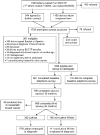Return to work in low-income Latina and non-Latina white breast cancer survivors: a 3-year longitudinal study
- PMID: 22009703
- PMCID: PMC3263326
- DOI: 10.1002/cncr.26478
Return to work in low-income Latina and non-Latina white breast cancer survivors: a 3-year longitudinal study
Abstract
Background: Previous research has found an 80% return-to-work rate in mid-income white breast cancer survivors, but little is known about the employment trajectory of low-income minorities or whites. We set out to compare the trajectories of low-income Latina and non-Latina white survivors and to identify correlates of employment status.
Methods: Participants were low-income women who had localized breast cancer, spoke English or Spanish, and were employed at the time of diagnosis. Interviews were conducted 6, 18, and 36 months after diagnosis. Multivariate logistic regression was used to identify independent correlates of employment status at 18 months.
Results: Of 290 participants, 62% were Latina. Latinas were less likely than non-Latina whites to be working 6 months (27% vs 49%; P = .0002) and 18 months (45% vs 59%; P = .02) after diagnosis, but at 36 months there was no significant difference (53% vs 59%; P = .29). Latinas were more likely to be manual laborers than were non-Latina whites (P < .0001). Baseline job type and receipt of axillary node dissection were associated with employment status among Latinas but not non-Latina whites.
Conclusions: Neither low-income Latinas nor non-Latina whites approached the 80% rate of return to work seen in wealthier white populations. Latinas followed a protracted return-to-work trajectory compared to non-Latina whites, and differences in job type appear to have played an important role. Manual laborers may be disproportionately impacted by surgical procedures that limit physical activity. This can inform the development of rehabilitative interventions and may have important implications for the surgical and postsurgical management of patients.
Copyright © 2011 American Cancer Society.
Figures


Similar articles
-
Ethnic differences in psychosocial service use among non-Latina white and Latina breast cancer survivors.J Psychosoc Oncol. 2017 Jul-Aug;35(4):424-437. doi: 10.1080/07347332.2017.1310167. Epub 2017 Mar 23. J Psychosoc Oncol. 2017. PMID: 28332946 Free PMC article.
-
Women With Breast Cancer Who Work For Accommodating Employers More Likely To Retain Jobs After Treatment.Health Aff (Millwood). 2017 Feb 1;36(2):274-281. doi: 10.1377/hlthaff.2016.1196. Health Aff (Millwood). 2017. PMID: 28167716 Free PMC article.
-
Long-term financial burden of breast cancer: experiences of a diverse cohort of survivors identified through population-based registries.J Clin Oncol. 2014 Apr 20;32(12):1269-76. doi: 10.1200/JCO.2013.53.0956. Epub 2014 Mar 24. J Clin Oncol. 2014. PMID: 24663041 Free PMC article.
-
A contextual approach to understanding breast cancer survivorship among Latinas.Psychooncology. 2012 Feb;21(2):115-24. doi: 10.1002/pon.1998. Epub 2011 Jun 14. Psychooncology. 2012. PMID: 21674680 Free PMC article. Review.
-
Factors Impacting Management of Breast Cancer-Related Lymphedema (BCRL) in Hispanic/Latina Breast Cancer Survivors: A Literature Review.Hisp Health Care Int. 2021 Sep;19(3):190-202. doi: 10.1177/1540415321990621. Epub 2021 Feb 8. Hisp Health Care Int. 2021. PMID: 33550878 Free PMC article. Review.
Cited by
-
Cancer survivors and adverse work outcomes: associated factors and supportive interventions.Br Med Bull. 2023 Apr 5;145(1):60-71. doi: 10.1093/bmb/ldac028. Br Med Bull. 2023. PMID: 36372773 Free PMC article. Review.
-
Job loss, return to work, and multidimensional well-being after breast cancer treatment in working-age Black and White women.J Cancer Surviv. 2023 Jun;17(3):805-814. doi: 10.1007/s11764-022-01252-6. Epub 2022 Sep 14. J Cancer Surviv. 2023. PMID: 36103105 Free PMC article.
-
Are cancer-related decision aids appropriate for socially disadvantaged patients? A systematic review of US randomized controlled trials.BMC Med Inform Decis Mak. 2016 Jun 6;16:64. doi: 10.1186/s12911-016-0303-6. BMC Med Inform Decis Mak. 2016. PMID: 27267490 Free PMC article.
-
A Digital Coaching Intervention for Cancer Survivors With Job Loss: Retrospective Study.JMIR Cancer. 2021 Nov 23;7(4):e31966. doi: 10.2196/31966. JMIR Cancer. 2021. PMID: 34710853 Free PMC article.
-
Health-Related Quality of Life of Food-Insecure Ethnic Minority Patients With Cancer.J Oncol Pract. 2015 Sep;11(5):396-402. doi: 10.1200/JOP.2015.003962. Epub 2015 Aug 18. J Oncol Pract. 2015. PMID: 26286100 Free PMC article.
References
-
- Engel J, Kerr J, Schlesinger-Raab A, Eckel R, Sauer H, Holzel D. Predictors of quality of life of breast cancer patients. Acta Oncologica. 2003;42(7):710–8. - PubMed
-
- Bouknight RR, Bradley CJ, Luo Z. Correlates of return to work for breast cancer survivors. Journal of Clinical Oncology. 2006;24(3):345–53. - PubMed
-
- Drolet M, Maunsell E, Brisson J, Brisson C, Masse B, Deschenes L. Not working 3 years after breast cancer: Predictors in a population-based study. Journal of Clinical Oncology. 2005;23(33):8305–12. - PubMed
Publication types
MeSH terms
Grants and funding
LinkOut - more resources
Full Text Sources
Medical

